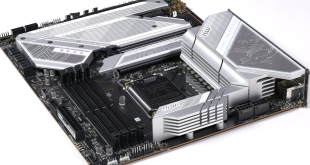Firstly, we are pleased to report that our Leetgion Hellion mouse worked to its usual standard in the Asus Maximus VI Hero motherboard's UEFI BIOS. This is a positive point as we have experienced problems when using certain mice in the UEFI BIOS of other motherboards in the past.
The Maximus VI Hero motherboard's UEFI BIOS is largely identical to that found on the Extreme. There are some minor changes which typically relate to overclocking flexibility.
The Extreme Tweaker section of the Maximus VI Hero's UEFI BIOS is very similar to that of other Asus motherboards, especially those from the ROG series. Upon entering the Extreme Tweaker page, users are greeted by a well laid-out and easy to understand interface with plenty of tweaking options.
Plenty of CPU power and voltage adjustment settings can be accessed via their dedicated pages.
The main components that are connected to one's motherboard are outlined on the GPU.DIMM Post page of the Extreme Tweaker section.
The Maximus VI Hero does not feature any customised overclocking profiles. Instead, it features three ‘CPU level up' speed boosts which increase the processor's multiplier and VCore level.
Asus equips the M6H with a maximum memory multiplier of 32x. Plenty of timings settings can be accessed and manipulated.
The list of pre-defined memory overclocking profiles found on the Maximus VI Extreme is left out of the Hero's UEFI BIOS.
System information is outlined on the ‘Main' page of the UEFI BIOS.
Onboard controllers and other settings can be accessed through the Advanced subsection. A specific section can be used to set the PCI-E lane configuration which is good for ensuring that a single card receives full bandwidth.
The monitor section provides access to temperature, voltage, and fan control readings. The fan speed control featured on the Maximus VI Hero motherboard is very similar to what we have seen on Asus motherboards in previous generations; certain modes (such as Turbo and Silent) can be applied, or somewhat confined parameters can be tweaked to change fan speed and the target CPU temperature.
Boot settings can be changed under the ‘Boot' section.
Being an ROG product, Asus provides some noteworthy tools with the Maximus VI Hero motherboard. Perhaps the most useful of all is ROG SSD Secure Erase. It can be used to erase data from and reset the performance of a supported SSD by ‘cleaning' the NAND chips. This is a highly useful tool that can save many hours when trying to restore the performance of an SSD that doesn't have specific restoration software available.
ROG SSD Secure Erase worked perfectly with our 120GB Kingston HyperX 3K drive.
Up to eight overclocking profiles can be saved to the M6H. These profiles can be easily transferred to and from the motherboard with a USB flash drive.
Quick access to settings can be accomplished by adding them to the favourites page.
A note can be added to the BIOS profile which can be helpful when testing stable overclocks. A log outlines the previously modified parameters so that accidental settings aren't applied.
Upon hitting F10 to save the configuration and exit the BIOS, a window pops up displaying all of the settings that have been tweaked in this visit to the BIOS. This is a good feature that offers an extra line of protection in the case of an incorrect setting being applied.
Asus has implemented an excellent UEFI BIOS for the Maximus VI Hero, and in doing so, has managed to maintain most of the key features from the Extreme motherboard's interface. It is attractive, easy to use, and features plenty of customisable options.
Sonic Radar
One piece of ROG software that really caught our attention was Sonic Radar. The tool is an overlay that indicates the direction of interaction in a game. For example, the radar shows the direction of enemy gunfire, footsteps, or even explosions and vehicle movement in a shooting game.
The Sonic Radar piece of software is bundled in with the Realtek audio installer. Typing ‘Sonic Radar' into the Windows search box will bring up the tool.
Eager to test this out, we loaded up Battlefield 3. The Battlefield 3 game didn't want to work when Sonic Radar was running. To overcome this problem, we simply loaded Battlefield 3, before opening up Sonic Radar once the game had launched.
The overlay can be set to lie in different areas of the screen.
Sensitivity was the first characteristic that we noticed about Sonic Radar. The overlay is very sensitive towards any type of noise that is created in the game. At some points, it can seem a little jerky due to the rapidly adjusting interaction lines.
The radar did work correctly for our spell of Battlefield 3, and a quick test with Metro 2033, provided the enemies were in front of the character. Turn the player around and the radar continues to display the gunfire as coming from the forward direction when it was really coming from behind. This certainly was an irritating shortfall and one that we hope Asus will fix soon.
While Sonic Radar is a convenient tool that does provide some assistance in FPS games, I wouldn't call it a feature that makes me want to rush out and buy an ROG motherboard specifically for it. That said, the tool's importance and relevance are entirely related to one's individual preference. Changing the overlay's on-screen position may have also changed my usage style.
 KitGuru KitGuru.net – Tech News | Hardware News | Hardware Reviews | IOS | Mobile | Gaming | Graphics Cards
KitGuru KitGuru.net – Tech News | Hardware News | Hardware Reviews | IOS | Mobile | Gaming | Graphics Cards



































